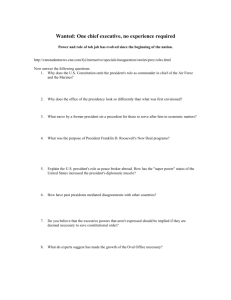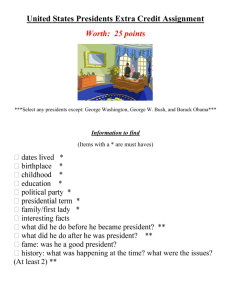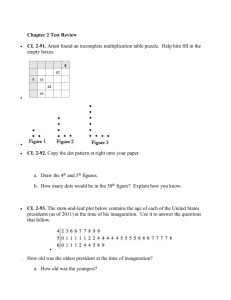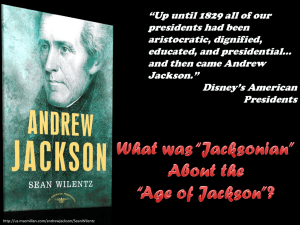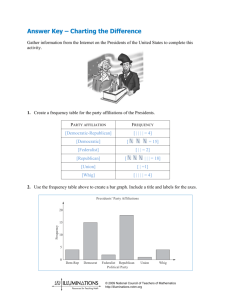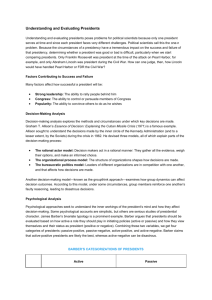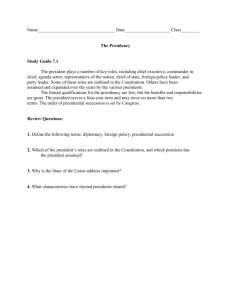Ranking Our Presidents - World History International
advertisement
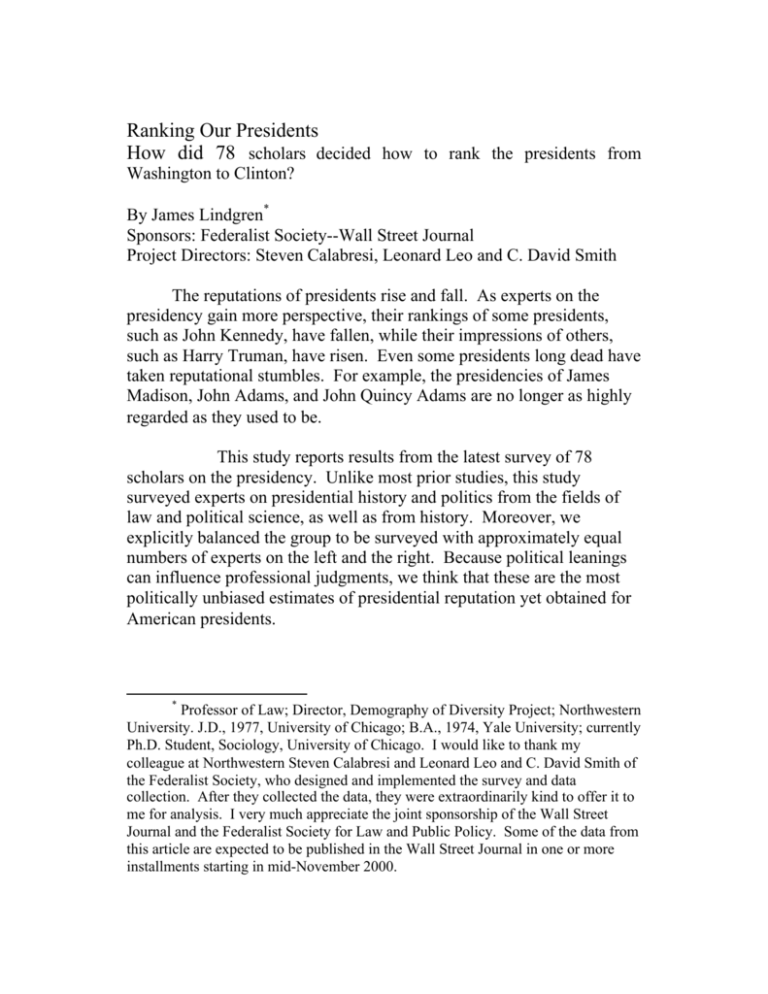
Ranking Our Presidents How did 78 scholars decided how to rank the presidents from Washington to Clinton? By James Lindgren* Sponsors: Federalist Society--Wall Street Journal Project Directors: Steven Calabresi, Leonard Leo and C. David Smith The reputations of presidents rise and fall. As experts on the presidency gain more perspective, their rankings of some presidents, such as John Kennedy, have fallen, while their impressions of others, such as Harry Truman, have risen. Even some presidents long dead have taken reputational stumbles. For example, the presidencies of James Madison, John Adams, and John Quincy Adams are no longer as highly regarded as they used to be. This study reports results from the latest survey of 78 scholars on the presidency. Unlike most prior studies, this study surveyed experts on presidential history and politics from the fields of law and political science, as well as from history. Moreover, we explicitly balanced the group to be surveyed with approximately equal numbers of experts on the left and the right. Because political leanings can influence professional judgments, we think that these are the most politically unbiased estimates of presidential reputation yet obtained for American presidents. * Professor of Law; Director, Demography of Diversity Project; Northwestern University. J.D., 1977, University of Chicago; B.A., 1974, Yale University; currently Ph.D. Student, Sociology, University of Chicago. I would like to thank my colleague at Northwestern Steven Calabresi and Leonard Leo and C. David Smith of the Federalist Society, who designed and implemented the survey and data collection. After they collected the data, they were extraordinarily kind to offer it to me for analysis. I very much appreciate the joint sponsorship of the Wall Street Journal and the Federalist Society for Law and Public Policy. Some of the data from this article are expected to be published in the Wall Street Journal in one or more installments starting in mid-November 2000. 11/16/2000 Rating the Presidents Page 2 To choose the scholars to be surveyed, we had three expert panels of two scholars in each field come up with a list of experts in their field. The six scholars who consulted on the makeup of the sample were Akhil Reed Amar (Yale University), Alan Brinkley (Columbia University), Steven G. Calabresi (Northwestern University), James W. Ceaser (University of Virginia), Forrest McDonald (University of Alabama), and Stephen Skrowronek (Yale University). We tried to choose approximately equal numbers of scholars who lean to the left and to the right. Our goal was to present the opinions of experts, controlling for political orientation. Another way to express this is that we sought to mirror what scholarly opinion might be on the counterfactual assumption that the academy was politically representative of the society in which we live and work. This study attempts to resolve the conflict between prior rankings of presidents done mostly by liberal scholars or mostly by conservative scholars,1 but not by both together. As in prior studies, George Washington, Abraham Lincoln, and Franklin Roosevelt continue to be the most esteemed presidents. Also like other studies, Democratic presidents tend to be rated higher than Republican presidents (though insignificantly so), both overall and since 1857. No demographic data were collected on the 78 respondents (59% response rate)--30 historians, 25 political scientists, and 23 law professors. Where possible, we have quoted from the comments of scholars who responded to the survey. 1 Arthur M. Schlesinger, Jr., Rating the Presidents: Washington to Clinton, 112 Political Science Quarterly 179 (1997) (mostly liberal scholars); William J. Ridings, Jr. and Stuart B. McIver, Rating the Presidents: From the Great and Honorable to the Dishonest and Incompetent (1997) (presumably mostly liberal scholars); Alvin S. Felzenberg, “There You Go Again”: Liberal Historians and the New York Times Deny Ronald Reagan His Due, Policy Review, March-April 1997 (criticized by Schlesinger as “inviting the same suspicion” of political bias as his panel, though from the other side). 11/16/2000 Rating the Presidents Page 3 Each scholar was asked to rate each President2 on a standard social science five-point scale from well below average to highly superior3 and to name the most over- and underrated presidents.4 Historian Paula Baker was one of many scholars who explained her criteria: “Highly superior and above average presidents made the most of what circumstances provided, and in a few cases, reoriented their parties and public life.” The scholars we surveyed were supposed to rate them as presidents, but undoubtedly their other accomplishments sometimes affected the ratings. One respondent explicitly rejected this tendency, “Some of the low-ranking presidents [as he ranked them], such as John Quincy Adams, Martin Van Buren, and William Howard Taft, were able men who contributed a great deal to the nation, but not as president.” This strange modern genre of presidential rankings was initiated in 1948 by Arthur Schlesinger, Sr., who repeated his study in 1962.5 In 2 We asked them to rank all 41 presidents but dropped the data on James Garfield and William Harrison because of their very brief terms in office. 3 The scholars were asked: “Please rate each president using the table below. In deciding how to rate a president, please take into consideration the value of the accomplishments of his presidency and the leadership he provided the nation, along with any other criteria you deem appropriate.” PRESIDENT HIGHLY SUPERIOR ABOVE AVERAGE AVERAGE BELOW AVERAGE WELL BELOW AVERAGE 4 The scholars were asked: “Please identify the five most overrated or underrated Presidents of the United States, indicating whether they are overrated or underrated.” They were given five blank lines and were given the opportunity to circle “UNDERRATED” or “OVERRATED.” 5 See Arthur M. Schlesinger, Jr., Rating the Presidents: Washington to Clinton, 112 Political Science Quarterly 179, 179 (1997) (describing his father’s studies for Life Magazine in 1948 and the New York Times Magazine in 1962). 11/16/2000 Rating the Presidents Page 4 1996 his son, Arthur Schlesinger, Jr., replicated the study.6 Our study, conducted in October 2000, found remarkably similar results to the last Schlesinger study. The correlation between the ranks in the two studies is a staggeringly high .94.7 The main difference between the two studies is that Ronald Reagan ranks eighth in our study, while he ranked 25th (out of 39 presidents) in Schlesinger’s 1996 study. Compared to the Schlesinger study, there are some methodological differences. Like Schlesinger, we surveyed 30 historians, but in place of his two politicians (Mario Cuomo and former Senator Paul Simon), we surveyed 25 political scientists and 23 law professors. While Schlesinger surveyed one woman and no non-white minorities, about 15% of our respondents were women and minorities, a substantial proportion only by comparison. We believe that we also surveyed more young professors than Schlesinger did. I. Ranking the Presidents Rating presidents is an odd practice. No one can be an expert on all periods. Many presidents (e.g., Ulysses Grant, Calvin Coolidge, and Warren Harding) are probably rated more on received wisdom than on assessments of their records. The historian Robert Ferrell argues that, once one goes beyond one’s narrow area of expertise, there is “a rapid diminution of real authoritative judgment.” Even someone who has 6 Id. (1996 study, results published first in the New York Times Magazine in 1996, followed by a scholarly paper published in 1997). 7 This result comes after correcting the Schlesinger ranks for several arithmetical errors (he appears not to have used a spreadsheet, since, e.g., the second category was weighted 2 points for some presidents and 1 point for most presidents), but making no changes in coding. Besides arithmetical errors, the Schlesinger study coded the bottom category in their 5 category scale –2, 3 points below the category just above it. With more conventional coding (an even one point spread between categories), the correlation is .956 with our ranks is a stunning R2 of .913. If you leave out the one outlier, Ronald Reagan, the correlation between ranks is .970, with an R2 of .940. 11/16/2000 Rating the Presidents Page 5 written more than a dozen books on the presidency, Ferrell asserts, would “almost have to guess” for some of the presidents. Some respondents reflected this cautiousness. Historian Mark Leff argues, “Global measures can be an empty exercise.” Political scientist Karen Hult notes that rankings of U.S. presidents are problematic: “First, as summaries, they by necessity mask what may be important differences within administrations.” Some presidents may be better at some tasks than others or better at different times within their administrations. “Second,” she argues, “rankings of presidents appear to me to reinforce the too-frequent tendency in the United States to attribute more power to the individuals who occupy the Oval Office than they typically have (or had).” Respondents used different criteria in ranking presidents. Many favored their own evaluations of the presidents’ goals and accomplishments. Others, such as legal scholar Annette Gordon-Reed, emphasized the presidents’ own goals: “I tried to make decisions based upon the extent to which each man was able to accomplish what he set out to do rather than relying only on my opinion of the worth of their efforts.” A. The Best Presidents “The plain fact is that over half of our presidents have been mediocrities,” Writes historian Robert Rutland. Political scientist Thomas Cronin was more sanguine, “[A]t least two dozen individuals have served with distinction; only a few have been grossly inadequate.” Some presidents were ranked highly by almost everyone in our study. The eleven presidents ranked highest in this survey all made it into Schlesinger's top ten, except Ronald Reagan. (They are presented here in Chart 1.) George Washington ranked first, while Abraham Lincoln and Franklin Roosevelt came in second and third respectively... As historian Steven Gillon remarks simply in his comments on the survey, “Washington, Lincoln, and FDR remain--and should remain--in a class by themselves.” 11/16/2000 Rating the Presidents Page 6 Just a step below are Thomas Jefferson (fourth) and Theodore Roosevelt (fifth). All five of these presidents averaged well above 4.0 on a 5 point scale. Rounding out the top eleven are: Andrew Jackson, Harry Truman, Ronald Reagan, Dwight Eisenhower, James Polk and Woodrow Wilson. Some scholars may have thought that Jefferson’s reputation was slipping, partly because of an increase in discussions of his slaveholding in general and his probable fathering of children with Sally Hemings. Political scientist David Mayhew’s comment expressed this concern, “Jefferson is getting downgraded these days, but after reading Henry Adams’ volumes recently, I see him as first-rate.” Chart 1: The 11 Best U.S. Presidents Ranked by Mean Score Data Source: October 2000 Survey of Scholars in History, Politics, and Law (n=73-78) Co-Sponsors: Federalist Society & Wall Street Journal 1. George Washington 4.92 4.87 2. Abraham Lincoln 3. Franklin Roosevelt 4.67 4. Thomas Jefferson 4.25 5. Theodore Roosevelt 4.22 6. Andrew Jackson 3.99 7. Harry Truman 3.95 8. Ronald Reagan 3.81 9. Dwight Eisenhower 3.71 10. James Polk 3.70 11. Woodrow Wilson 3.68 0.00 0.50 1.00 1.50 2.00 2.50 Mean Rating 3.00 3.50 4.00 4.50 5.00 11/16/2000 Rating the Presidents Page 7 B. The Worst Presidents According to the 78 experts on our panel, the worst president was James Buchanan (ranked 39th), followed by Warren Harding and Franklin Pierce (tied for 37th). Buchanan and Pierce are usually blamed for doing little to head off the impending Civil War. Of those presidents in the bottom ten, five did not serve even one full term: Harding , Andrew Johnson (36th), Millard Fillmore (35 th), John Tyler (34th), and Zachary Taylor (31st). In addition, Richard Nixon (33rd) was forced from office and Andrew Johnson was impeached by the Republicans shortly after the Civil War. The administration of Ulysses Grant (32nd) is remembered today a bit unfairly mostly for scandal. Although Jimmy Carter is usually praised for the Middle East Peace Agreement and blamed for his handling of Iran, he gets little credit for his deregulation of the trucking and airlines industries. Chart 2: The 10 Worst U.S. Presidents Ranked by Mean Score Data Source: October 2000 Survey of Scholars in History, Politics, and Law (n=73-78) Co-Sponsors: Federalist Society & Wall Street Journal 2.47 30. Jimmy Carter (10th worst) 31. Zachary Taylor 2.40 32. Ulysses Grant 2.28 2.22 33. Richard Nixon 2.03 34. John Tyler 35. Millard Fillmore 1.91 36. Andrew Johnson 1.65 37T. Warren Harding 1.58 37T. Franklin Pierce 1.58 39. James Buchanan (worst) 1.33 0.00 0.50 1.00 1.50 Mean Rating 2.00 2.50 3.00 11/16/2000 Rating the Presidents Page 8 C. Grouping the Presidents It has been traditional to group the presidents as “great,” “near great,” and so on. While any such classifications are arbitrary, we can group using our scores in something like these traditional categories. Remember, however, that our respondents did not use these particular characterizations; these are applied after the fact to group the results. There may be some surprises here. As time has passed since the Kennedy administration, the rankings of his presidency have slipped. In this study Kennedy (18th) appeared at the bottom of the “above average” group, somewhat below his ranking in the last Schlesinger survey (12th). Ronald Reagan and Dwight Eisenhower moved into the “near great” group. Both had, not only high mean scores, but a high median of 4. Reagan’s ratings were highly variable; Eisenhower’s were not. Eisenhower had been at the top of Schlesinger’s “high average” group; by moving up just one place in our study, he moved into the “near great” category. Reagan had been in Schlesinger’s “average” category. In our study, he moves into the group of “near great” presidents. William Clinton (24th), although below both the mean and the median for all 39 presidents, still inhabits our “average” category, a few slots below George H.W. Bush (21st). In our study, Clinton slips four places from the 1996 Schlesinger survey. Carter and Nixon both had low median ratings of 2.0. In Nixon’s case, this low rating reflects what many believe to be his mostly disastrous domestic, international, and economic policies, not to mention the corruption of his administration. Table 1 Ranking of Presidents by Mean Score Data Source: October 2000 Survey of Scholars in History, Politics, and Law (n=73-78) Co-Sponsors: Federalist Society & Wall Street Journal Great 1 2 3 Mean Median Std. Dev. George Washington Abraham Lincoln Franklin Roosevelt 4.92 4.87 4.67 5 5 5 0.27 0.60 0.75 Thomas Jefferson Theodore Roosevelt Andrew Jackson Harry Truman Ronald Reagan Dwight Eisenhower James Polk Woodrow Wilson 4.25 4.22 3.99 3.95 3.81 3.71 3.70 3.68 4 4 4 4 4 4 4 4 0.71 0.71 0.79 0.75 1.08 0.60 0.80 1.09 Grover Cleveland John Adams William McKinley James Madison James Monroe Lyndon Johnson John Kennedy 3.36 3.36 3.33 3.29 3.27 3.21 3.17 3 3 3 3 3 3.5 3 0.63 0.80 0.62 0.71 0.60 1.04 0.73 William Taft John Quincy Adams George Bush Rutherford Hayes Martin Van Buren William Clinton Calvin Coolidge Chester Arthur 3.00 2.93 2.92 2.79 2.77 2.77 2.71 2.71 3 3 3 3 3 3 3 3 0.66 0.76 0.68 0.55 0.61 1.11 0.97 0.56 Benjamin Harrison Gerald Ford Herbert Hoover Jimmy Carter Zachary Taylor Ulysses Grant Richard Nixon John Tyler Millard Fillmore 2.62 2.59 2.53 2.47 2.40 2.28 2.22 2.03 1.91 3 3 3 2 2 2 2 2 2 0.54 0.61 0.87 0.75 0.68 0.89 1.07 0.72 0.74 Andrew Johnson Franklin Pierce Warren Harding James Buchanan 1.65 1.58 1.58 1.33 1 1 1 1 0.81 0.68 0.77 0.62 Near Great 4 5 6 7 8 9 10 11 Above Average 12 13 14 15 16 17 18 Average 19 20 21 22 23 24 25 26 Below Average 27 28 29 30 31 32 33 34 35 Failure 36 37T 37T 39 11/16/2000 Rating the Presidents Page 10 D. The Most Controversial Presidents Several presidents had highly variable ratings. As one historian responding to our survey points out, “It’s hard to make judgments about recent presidents . . . .” Perhaps not surprisingly, Bill Clinton had the highest variation in our ratings, followed by Wilson and Reagan. Not only has there not been time to assess Clinton's presidency with dispassion, but also many of the respondents were among the distinguished academics who signed public letters either opposing or supporting Clinton’s impeachment. Chart 3: The Most Controversial Presidents (Standard Deviations in the Rankings of Presidents on a 1-5 Scale; Survey of Scholars in History, Law, and Political Science, October 2000, n=73-78) 1. Bill Clinton 1.11 2. Woodrow Wilson 1.09 3. Ronald Reagan 1.08 4. Richard Nixon 1.07 5. Lyndon Johnson 1.03 6. Calvin Coolidge 0.97 7. Ulysses Grant 0.89 8. Herbert Hoover 0.87 9. Andrew Johnson 0.81 10. James Polk 0.00 0.80 0.20 0.40 0.60 0.80 1.00 Clinton has his strong supporters. “Clinton has been a great President even with the impeachment,” one prominent law professor commented. “[D]espite the disgrace of impeachment, he helped develop a new modest liberalism that was appropriate for the times," historian Steven Gillon remarked 1.20 11/16/2000 Rating the Presidents Page 11 Political scientist Gary Gregg takes the opposite position on Clinton’s style: “The symbolic aspects of the presidency are well underrated. . . . This is one reason Reagan should be ranked higher than he generally is and why Bill Clinton must be seen to be a disaster for the office. From talking about his underwear on t.v., to his ‘short shorts’ he wore jogging around Washington, to the Lewinsky affair, he has done much to damage the symbolic import of the office.” Other presidents with high variability in their ratings include Reagan, Wilson, Nixon, and Lyndon Johnson. Wilson has been undergoing a critical reappraisal recently, as his creation of federal agencies is more controversial than it once was and his handling of World War I and its aftermath is not judged as positively as it once was. Reagan has made a quick move to the “near great” group, a move fueled in this study in part from surprisingly high ratings from many academics thought to lean to the left. Lyndon Johnson remains a controversial figure because he passed the most aggressive domestic legislative agenda of the post-World War II era. Some of that legislation (e.g., the 1964 Civil Rights Act) is viewed almost universally as positive; other parts of that agenda generally have widely varying support among academics. As law professor John McGinnis argues about Lyndon Johnson, “Often rated above average, he should be rated well below average. He fought two wars (in Vietnam and against poverty) and lost both of them. The consequences of these policies still harm our polity almost forty years later.”8 8 Law professor Joel Goldstein partly agreed, “Notwithstanding Johnson’s success as a legislative leader in 1964 and 1965, I do not see how he can fairly be rated "near great" owing to his mismanagement of the Vietnam War. That effort, which had no clear mission, was a debacle for the country, the Presidency, and the American government.” 11/16/2000 Rating the Presidents Page 12 E. The Most Over-Rated Presidents We asked the scholars surveyed to list the most overrated and underrated presidents. Because this question refers to an unstated baseline reputation, the results are not terribly meaningful. Moreover, one professor listed Richard Nixon as both over-rated and under-rated and another listed Reagan the same--a result that is not necessarily incoherent because they might well be overrated by one group of scholars and underrated by another (or overrated for some attributes and underrated for others). Enough of our respondents (16) cited Ronald Reagan as underrated that he leads that list, while even more respondents (23) listed him as overrated. Joel Goldstein explained why he listed Reagan as overrated: “[D]espite Reagan’s successes vis a vis the Soviet Union, other aspects of his foreign policy were disasters (e.g., Iran-Contra, Lebanon) and his economic policies produced recession and huge deficits.” One historian argued, “Reagan’s champions have been too quick to credit him with ending the Cold War, and have brushed past a range of failures from civil rights to the environment to Iran-Contra.” 11/16/2000 Rating the Presidents Page 13 Chart 4: The Most Over-Rated Presidents Number of Scholars Ranking a President as Over-Rated Data Source: October 2000 Survey of Scholars in History, Politics, and Law Co-Sponsors: Federalist Society & Wall Street Journal 1. John Kennedy 43 2. Ronald Reagan 23 21 3. Woodrow Wilson 4. Andrew Jackson 10 4. Thomas Jefferson 10 6. Bill Clinton 8 6. Lyndon Johnson 8 7 8. Franklin Roosevelt 9. Dwight Eisenhower 6 9. Harry Truman 6 0 5 10 15 20 25 30 35 40 Nonetheless, there was a shocking consensus on the most overrated president--John Kennedy. When the opportunity to name the most overrated presidents arose, 43 of the 78 scholars named John Kennedy. That a solid majority would volunteer his name suggests that his reputation is falling. Indeed, sometimes viewed in the category of the “near great,” Kennedy has now dropped into the bottom of the “above average” group. Indeed, he ranks one slot below Lyndon Johnson,9 who left office in disgrace. Political scientist Bruce Miroff argues: “Kennedy brought the Cold War to dangerous heights.” Nonetheless, Kennedy has his defenders. One law professor argues that Kennedy was underrated, “Kennedy transformed American 9 The difference is not statistically significant. 45 50 11/16/2000 Rating the Presidents Page 14 politics; bringing to it a sense of personal style and the conviction that politics could be both idealistic and pragmatic.” Like Ronald Reagan and John Kennedy, Woodrow Wilson also has very substantial numbers of respondents who consider him overrated.10 F. The Most Underrated Presidents The scholars we surveyed list fewer presidents as underrated than overrated. Ronald Reagan is cited by more respondents as underrated than any other president--though ranked eighth in this survey, he cannot be dramatically underrated here. Nor can Eisenhower, ranked ninth overall in our survey. Calvin Coolidge, on the other hand, is cited by 14 scholars as underrated, yet his overall scores in our survey are below average. 10 In describing why he considered Wilson, Jefferson, Jackson, and Franklin Roosevelt “near great,” government professor Harvey Mansfield argues, “The neargreat presidents were all great partisans who founded or remade their parties and are still controversial today . . . .” 11/16/2000 Rating the Presidents Page 15 Chart 5: The Most Under-Rated Presidents (Number of Scholars Ranking a President as Under-Rated; Data Source: October 2000 Survey of 78 Scholars in History, Politics, and Law Co-Sponsors: Federalist Society & Wall Street Journal 1. Ronald Reagan 16 2. Calvin Coolidge 14 3. Dwight Eisenhower 12 3. Herbert Hoover 12 5. Richard Nixon 11 5. James Polk 11 7. Jimmy Carter 10 8. Ulysses Grant 9 9. Lyndon Johnson 8 10. John Adams 6 10. William McKinley 6 0 2 4 6 8 10 12 14 II. Predictors of High Presidential Ratings In this section, we briefly explore differences in ratings within our sample and possible variables that might explain them. First, we examined presidential age at inauguration. Using linear regression with just 39 observations (one for each president),11 with a constant in the 11 Because the observations for each president are not independent, we decided to use the cautious assumption of only 39 cases. For that reason, one should assume that the power of these data are not sufficient to reject reliably the null hypothesis for any effects that seem somewhat large but are not statistically significant. 16 18 11/16/2000 Rating the Presidents Page 16 model there is no relationship between the age of a president and his mean rating by scholars. Thus, age at inauguration has no effect on measured presidential success. Models 2-4 examine the comparative ratings of Republicans and Democrats. This is complicated by the classification of Andrew Johnson. Andrew Johnson was a Democrat who had served as the military governor of Tennessee. Lincoln chose him to join the “National Union” ticket. In office, Johnson opposed many Republican Reconstruction measures and was impeached by the Republicans. Treating Johnson as a Republican (Model 2), the mean rating for Democratic presidents since 1857 (the period of Republican-Democratic contests) is .26 points higher (on a 1-5 scale) for Democrats than for Republicans. If Johnson is treated as a Democrat, the ratings are almost identical between parties (+.03 points for Democrats). Neither difference is statistically significant. Going back to 1797 (and treating Johnson as a Republican), the mean rating for Democratic (and Democratic-Republican) presidents is an insignificant .38 points higher than that of Federalists, Whigs, and Republicans (model 4). 11/16/2000 Rating the Presidents Page 17 Table 2 Linear Regression Models Rating of Presidents by Length of Term, Age, Party, and Method of Nomination Data Source: October 2000 Survey of 78 Scholars in History, Politics, and Law Co-Sponsors: Federalist Society & Wall Street Journal Model Model Model Model Model B for R R2 F Signif. Constant Variables B S.E. Signif. R Age .00 .02 .86 .03 Dem. Since 1857 without .26 Andrew Johnson .37 .48 .15 .03 .36 .93 .02 Dem. without A. Johnson .38 .28 .18 .22 1 .03 .00 .03 .86 2.81 2 .15 .02 .51 .48 2.65 3 .02 .00 .01 .93 2.96 4 .22 .05 1.86 .18 2.44 5 .36 .13 5.34 0.026* 2.07 Before Conventions .83 .36 0.026* .36 6 .64 .41 12.73 <.0005* 2.66 2 Terms .95 .26 0.001* .53 Less Than 1 Full Term -.45 .33 .18 -.20 2 Terms .89 .25 0.001* .50 Less Than 1 Full Term -.38 .33 .26 -.16 Before Conventions .50 .30 .11 .21 7 .68 .46 9.82 <.0005* 2.09 Democrat Since 1857 with Andrew Johnson Next we examined whether the presidential ratings were higher before Andrew Jackson opened up the process of nominating presidents. Before Jackson, candidates were usually chosen by slatemaking in the congressional caucus. With Jackson’s encouragement, political parties moved to choosing candidates in national party conventions. This corresponded with a Jacksonian revolution in extending the franchise to 11/16/2000 Rating the Presidents Page 18 wider segments of the adult white male population. Counting Jackson as a product of the older era, the presidents picked before the populist era of national party conventions rated a significant .83 points higher than the later presidents (Model 5). Models 6 and 7 assess the contribution of the length of term in office on presidential ratings. In Model 6 those presidents who served less than one full term rated about a half point lower (-.45) than those who served just one full term. On the other hand, presidents who served parts of two terms (or more) rated nearly a full point higher (.95) than presidents who served just one term. In Model 7, when the variable time in office is combined with being elected in the period before nominating conventions, the latter variable loses its statistical significance. This suggests that about half of the higher ratings for the presidents from Washington through Jackson is explained by their greater likelihood of having two terms, not from being selected to run without conventions. Perhaps a greater likelihood of being elected for two terms was one of the outgrowths of the nominating process, though the weakness of the two-party system during much of the early 1800s must be an important factor as well. Two-term presidents are today rated much higher than one-term presidents. Thus, while John Kennedy ranks at the bottom of the “above average” group, he is first among presidents serving less than one full term and third among presidents serving in only one term. (James Polk and John Adams are the two one-term presidents ahead of him.) By contrast, Bill Clinton, ranked 24th overall, is rated lower than all presidents serving two full terms except Ulysses Grant. III. Comparing the Responses of Scholars in History, Law, and Political Science Scholars in different fields see the world somewhat differently. Although we observed few large field-specific differences in ranking U.S. Presidents, there were several. The politics scholars were seldom 11/16/2000 Rating the Presidents Page 19 the outliers in opinion. Historians were substantial outliers on two presidents: They ranked Bill Clinton eight places higher than law professors and seven places higher than political scientists. Historians also ranked Ronald Reagan eight places lower than law professors and five places lower than politics professors. Law professors were outliers on even more presidents. They ranked two presidents substantially lower than did the other groups: Rutherford Hayes (11 places lower than historians and eight places lower than politics scholars) and Lyndon Johnson (nine places lower than the other two fields). Legal scholars also ranked three presidents substantially higher than did the other two fields: Calvin Coolidge (10 places higher than historians and six places higher than political scientists), Gerald Ford (nine places higher than historians and five places higher than political scientists), and Ulysses Grant (eight places higher than politics professors and five points higher than historians). To the extent that there were any systematic differences, in our survey historians slightly favored Democrats and law professors slightly favored Republicans. Our panels of historians and political scientists were perhaps less explicitly politically balanced than our law professor panel (which was split 12/11 between those believed to lean to the right and to the left). Thus, the panels of historians and politics scholars might have been a bit more liberal than the law professor panel or the general public. Because we did not collect demographic data on our respondents, we do not know. More interestingly, political scientists tend to rank presidents who had had major scandals lower than historians did: Bill Clinton (seven places lower than historians), Ulysses Grant (three places lower than historians and eight places lower than law professors), and Warren Harding (two places lower than historians and four places lower than law professors).12 Law professors, on the other hand, tend to favor presidents who have made significant legal contributions. Thus they ranked Washington 12 Nixon’s rank varies from 32-33 for all three groups. 11/16/2000 Rating the Presidents Page 20 slightly higher than Lincoln--pushing him into the top spot overall--and ranked Madison’s presidency higher than did the politics professors, perhaps in part for Madison’s earlier contributions to the Constitution. Further, Taft fares somewhat better with legal scholars than with other groups, perhaps because he was a successful Chief Justice of the Supreme Court after his presidency. The higher legal ratings for Grant certainly reflect his putting Reconstruction back on track and the passage of the 15th Amendment giving African-Americans the right to vote, as well as other important civil rights legislation. For most presidents, the field related differences shown in Table 3 are not large. Table 3 Ranking of Presidents by Scholarly Field by Mean Score Data Source: October 2000 Survey of Scholars in History, Politics, and Law (n=73-78) Co-Sponsors: Federalist Society & Wall Street Journal President Abraham Lincoln George Washington Franklin Roosevelt Theodore Roosevelt Thomas Jefferson Andrew Jackson Harry Truman Woodrow Wilson James Polk Dwight Eisenhower John Adams James Madison Ronald Reagan Lyndon Johnson William McKinley John Kennedy Grover Cleveland James Monroe John Quincy Adams Bill Clinton William Taft Rutherford Hayes Martin Van Buren George Bush Benjamin Harrison Chester Arthur Jimmy Carter Herbert Hoover Calvin Coolidge Gerald Ford Zachary Taylor Ulysses Grant Richard Nixon John Tyler Millard Fillmore Andrew Johnson Warren Harding Franklin Pierce James Buchanan History rank mean 1 4.93 2 4.90 3 4.87 4 4.43 5 4.24 6 4.03 7 4.03 8 3.83 9 3.79 10 3.69 11 3.61 12 3.52 13 3.47 14 3.40 15 3.36 16 3.27 17 3.25 18 3.24 19 3.07 20 3.00 21 2.97 22 2.83 23 2.76 24 2.70 25 2.64 26 2.57 28 2.52 27 2.52 29 2.37 30 2.30 31 2.30 32 2.28 33 2.13 34 2.00 35 1.83 36 1.64 37 1.53 38 1.41 39 1.30 Law Rank mean 2 4.70 1 4.96 4 4.17 6 3.91 3 4.22 7 3.83 8 3.70 15 3.26 10 3.57 9 3.65 18 3.17 13 3.33 5 4.09 23 2.83 14 3.30 20 3.04 12 3.35 11 3.45 22 2.90 28 2.61 16 3.26 30 2.57 26 2.67 17 3.22 25 2.71 24 2.74 32 2.35 29 2.61 19 3.17 21 2.91 31 2.50 27 2.65 33 2.22 34 2.14 37 1.77 36 1.91 35 2.14 38 1.65 39 1.52 Politics rank Mean 1 4.96 2 4.92 3 4.88 5 4.24 4 4.28 6 4.08 7 4.08 9 3.88 11 3.71 10 3.80 15 3.24 18 3.00 8 3.96 14 3.32 13 3.33 16 3.16 12 3.50 17 3.13 24 2.79 27 2.63 23 2.80 19 2.96 21 2.88 20 2.92 29 2.50 22 2.83 28 2.52 30 2.46 25 2.71 26 2.64 31 2.42 35 1.92 32 2.33 34 1.96 33 2.13 37 1.44 39 1.13 36 1.71 38 1.17 11/16/2000 Rating the Presidents Page 22 IV. Conclusion Ranking U.S. presidents is much more than a parlor game for academics and much less than a full assessment of the myriad successes and failures of the men who have held our highest office. Global measures, such as “above average” or “average” make sense only in comparative terms--and even then they are severely reductionist. Nonetheless, educating the public (as well as other scholars) about current assessments of presidents can contribute to understanding the history of the office, as well as give some perspective for evaluating the recent inhabitants of that office. This study further contributes to our knowledge of the presidency by showing that length of term in office is an important determinant of reputation. Two-term presidents are today rated much higher than oneterm presidents. This is somewhat in conflict with the common wisdom that second terms are always a failure, as well as with the idea that there is little correlation between electoral success and success in office. Of one thing we can be certain: Presidential reputations will change. The reputations of controversial recent presidents Bill Clinton and Ronald Reagan are particularly likely to either grow or lessen as we get more perspective on their accomplishments and failures. Being president is a tough job. Only one president in each century is rated high enough for us to call them “great”: George Washington in the 18th century, Abraham Lincoln in the 19th century, and Franklin Roosevelt in the 20th century. Perhaps sometime in this new century, we will have another.
